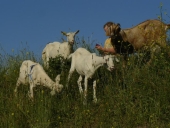




 2
2




I am only one, but still I am one. I cannot do everything, but still I can do something; and because I cannot do everything, I will not refuse to do something that I can do. (E.E.Hale)
 1
1




Anita Martini wrote:Hi Jen,
your plans sound good so far.
I think the sunchokes will do fine.
Have you checked what Sepp Holzer is growing? Austria and my part of the world (Bavaria, Germany) are about your climate zone.
I would try potatoes (early and late varieties), and around here the farmes plant winter wheat and rye which is now some inches tall but will jumpstart in spring.
If you have space and patience, some nut trees and bushes would be great for the future: walnut, hazelnut, acorns for the animals.
Sunflowers are planted around here, but you see few fields. In my garden the slugs kill most of them.
Runner beans do fine, but I have no luck with fava beans as we get late frosts and I can hardly harvest anything at all.
Good luck!
Anita
 1
1




Jen Fan wrote:
Really no luck with favas?! I grew fabulous favas here and they were quite frost hardy. They wre one of the first and most eager things to come in for me, and one the latest to keep producing. I grow them in a greenhouse, granted. I adore them! That's a bummer you haven't had much luck with em :(
I am only one, but still I am one. I cannot do everything, but still I can do something; and because I cannot do everything, I will not refuse to do something that I can do. (E.E.Hale)




Iterations are fine, we don't have to be perfect
My 2nd Location:Florida HardinessZone:10 AHS:10 GDD:8500 Rainfall:2in/mth winter, 8in/mth summer, Soil:Sand pH8 Flat




 1
1




S Bengi wrote:Grain-seeds are pretty cool but nut-seed is even better. Plant some nut trees.
Bee-Hive, use bees to help you harvest plant-nectar within a 3 mike radius, you can then add this honey to your animal feed. Even better turn it into water-kefir.
Fish pond, lots of plant matter thst can be used as feed, and fishes can also be used as feed, but stop 30days before slaughter to avoid a fishy taste.
Deer-Hunting, let the deer forage for offsite then harvest them when they showup on site.
It sounds like currently your 20acres has just about reached it carry capacity to feed your animals for 3months, if you had another 20acres you could silage it and have enough for 6 months and if you had a total of 80acres you would be golden. Inversely you could also cut the amount of animals you have to 1/4th.
Dont be afraid to supplement your animal feed with rock salt (multi-vitamin/multi-mineral)
Do you currently practice daily rotational grazing, with 30-45 paddocks?
Winter shelter can reduce how much calories/feed they spend keeping warm.





|
Your mother was a hamster and your father was a tiny ad:
Freaky Cheap Heat - 2 hour movie - HD streaming
https://permies.com/wiki/238453/Freaky-Cheap-Heat-hour-movie
|





